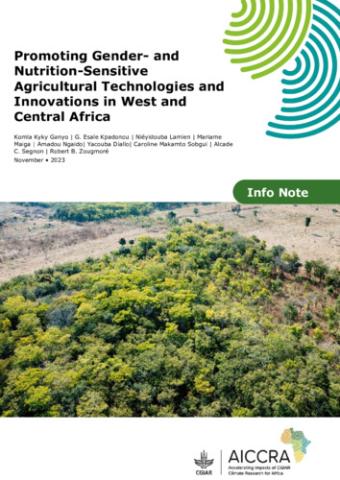Abstract
Agriculture plays a key role in all the poor countries of Sub-Saharan Africa (SSA). That agriculture plays a predominant role in SSA and provides livelihood to a bulk of the peoples (Modi, 2019). Women and young people are the main driving force behind small scale traditional agriculture (family farming), which provides almost 70% of the food needs of the entire African continent and produces around 80% of the food consumed in sub-Saharan Africa (SSA). Therefore, women and youth bear primary responsibility for food security in Africa.
Women are known to be more involved in agricultural activities than men in SSA countries (Ogunlela and Mukhtar, 2009). Not surprisingly, it is widely accepted that women make up 60-80% of the agricultural workforce in SSA (Palacios-Lopez et al., 2016). FAO in 1995 estimated women’s contribution to the production of food crops range from 30% in the Sudan to 80% in the Congo; contributing substantially to national agricultural production and food security, while being primarily responsible for the food crops. Further, women and young people work in all areas of agricultural production in Africa (cash and food production) and their involvement ranges from production to processing, sometimes involving arduous tasks. The arduous nature of the activities as well as socio-cultural and economic factors/barriers militates against gender (women and youth) in its participation in agricultural production.
Although, gender participation to agricultural production, women particularly are vulnerable to food insecurity, especially low income pregnant and lactating women (FAO, 2011). Food and nutrition security is described as a state when “adequate food is available and accessible for, and satisfactorily used and utilized by all individuals at all times to live a healthy and active life” (Weingärtner, 2004). The prevalence of undernourishment in Sub-Saharan Africa remains one of the higher rates in the world and is about in average at 24.1% percent (FAO/IFAD/UNICEF/WFP/WHO, 2020). Acquire and deploy agricultural technologies and innovations (T&I) that alleviate the suffering of women and young people and improve their nutritional and food security represent a crucial challenge for the future of agriculture and food security in Africa.
CORAF and its partners NARS in 23 countries have developed from 2008 to 2019 through the framework of West Africa Agriculture Productivity Program (WAAPP), over 320 T&Is for improving agricultural productivity and livelihoods (Ganyo et al., 2022). To enable a large-scale adoption, CORAF has set-up strategies for scaling-up its generated T&Is in West and Central Africa. Among those strategies for scaling T&Is includes MITA (Marché des Innovations et Technologies Agricoles), which is an annual physical market usually convening innovators, researchers, extension agents, agrodealers, farmers, private sector, and potential users (Kpadonou et al., 2022). CORAF's Market for Agricultural Innovations and Technologies (MITA) concept has proved its worth, as part of the implementation of WAAPP, which has enabled more than a hundred technologies to cross the borders of West and Central African countries. Today, MITA is on the way to being a major interface institution between agricultural research, providers of agricultural technologies and innovations, actors in agricultural value chains and consumers. CAADP-XP4, FSRP and AICCRA, three programmes implemented in CORAF have organized the third edition of MITA in Ouagadougou in 2023 which aims at promoting gender- and nutrition-sensitive T&Is that meet the needs of the various links/component (production, post-harvest, processing, mechanisation, etc.) in the agricultural value chains and Integrated Landscape Management.
This Info Note describes the process and outputs of MITA 2023 and gives next steps for massive acquisition and adoption of gender- and nutrition-sensitive T&Is.

